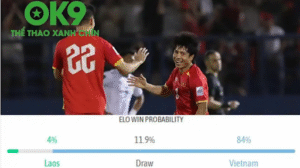The introductory phase is full of acronyms, disjointed tips, and a “follow the crowd” feeling. Instead of relying on luck, you need a simple framework that you can repeat every day. From reading background data, setting capital boundaries, to clearly describing entry and exit moments, this article helps you turn decisions into processes, reduce emotions, increase control, and keep the experience of Winning Goal Betting light. Ok9.
Building data mindset and safety boundaries

Before thinking about odds and doors, build a “concrete foundation” of clean data, neat terminology definitions and personal safety limits. When the foundation is solid, Ok9 Goal Betting will be less spontaneous and more systematic right from the first matches.
Mini dictionary and signal scale
A separate notebook helps you stay on top of the terminology. Write down concepts like xG, shots on target, and pressing rhythm, and how they translate into points. When everything is on a scale, you’re less likely to argue with your emotions and measure your progress over time within the Ok9 Goal Betting range.
Data integrity and record keeping
Good data has a source, a time, and a context. Be clear about where you got your numbers, when, and for which tournaments they apply. Keep your logs short but consistent, focusing on entry reasons, entry sizes, and exit reasons. Just one week of rigorous recording will help you spot recurring patterns that you can correct.
The boundary of capital and time
Set session and weekly limits, and set “soft stops” for when you lose focus. When you hit a boundary, stop right where you’re committed. Boundaries aren’t meant to hold you back, they’re meant to protect your sanity. This way, learning happens over time, not just a series of short-term results.
Betting with criteria, capital management in order

A good decision is one that has a visible reason, a proportionate scale, and a pre-written exit. The three-step framework below will help you keep your cool and take advantage of the moment when Ok9 Goal Winning Odds open up a clear opportunity.
Activation criteria before placing a bet
Don’t use your feelings. Set three easy-to-control conditions: your recent scoring form is not “fake” compared to the accumulated xG, your attacking line is on the field as expected, and your opponent tends to leave gaps at the time points you want to exploit. When the three conditions are in sync, the decision is disciplined, not spontaneous before Ok9 Goal Betting.
Scale in by confidence level with measure
Confidence needs a measuring stick to avoid being “inflated” by short-term winning streaks. Define three scales, each with a minimum signal point. When the score is not met, move back to the baseline; when it is clearly exceeded, move up a notch. This approach turns intuition into a contract with yourself, limiting impulsiveness.
Escape plan and stopping ritual
Exit correctly to preserve results and energy. Write down your take profit and stop loss conditions, and stay out when the rhythm fades. Include a very short pause ritual like breathing slowly, drinking water, and writing a three-line summary. When your body “learns” the pause rhythm, you are less likely to slip into an escalating spiral.
Real-time combat and context optimization

Goal odds are sensitive to the rhythm of the match and the context of the competition. When you know how to choose the time, filter noise and standardize the tool, you will hear the “sound of the machine” of the match more clearly, thereby implementing Ok9 Goal Odds coherently and less tired.
First half, second half and the moment of acceleration
Each team has a different fitness curve and execution habits between halves. Many teams start slowly, picking up the pace after the thirtieth minute; others explode early in the second half after adjusting. Build timing criteria into your plan, for example, only consider an “early burst” if both teams have a high shot-on-target percentage in the first fifteen minutes.
Filter out noise from schedules, weather, and dynamics
A tight schedule, long distance travel, and harsh weather reduce the quality of opportunities. The motivation to compete for relegation or continental qualification also directly affects the way they take risks. Filter the context first, then read the numbers. When the context supports the numbers, you will find Ok9 Goal Winning Odds more “trustworthy”.
Optimize devices, sources, and viewing environments
Network stability, clean screen, fewer side notifications, news feeds “bookmarked” by league group. On mobile, standardize odds and match schedule widgets; on desktop, separate browser profiles for analytics to avoid cookie confusion. Good context helps the mind spend a larger percentage of the decision.
To complete the beginner’s guide and add depth to the combat
This extension goes into how to build a personal data warehouse, how to read odds movements over time frames, modelling goal expectations, betting techniques in different game states, scenario-based capital management, and psychological exercises to help keep a cool head under pressure. The goal is to turn Ok9 Goal Betting into a repeatable chain of operations, where each decision is linked to observable evidence and has a clear exit.
Build a personal data warehouse without complicated tools
A neat spreadsheet that includes team, league, opponent, home or away, xG created and xG received, shot on target percentage, number of times in the 18m50 area, and specific tactical notes such as early or central crosses. Add two columns of match rhythm in fifteen-minute intervals and note the number of clear chances to identify the moment of acceleration. After a few rounds, you will see quite stable traces such as teams that usually start slowly but accelerate in the second half, or teams that usually accelerate in the beginning of the match and then slow down when leading. The more context the data warehouse has, the sharper the betting criteria.
Reading odds fluctuations should be associated with two time frames: before the ball rolls and during the match.

Before kick-off, watch for small movements that may come from personnel or weather reports; during the match, the movement of odds often reflects the actual game. A small but sustained movement over five consecutive minutes, accompanied by an increase in shots on target, is more reliable than a short spike with no shots. When odds move in the same direction as field data, the probability of the idea being right increases. If the two sources contradict each other, prioritize staying out or scaling down to the base level.
Conclude
A good playbook doesn’t promise instant wins, it gives you a process. When you use contextual data, set capital boundaries, clearly define entry and exit criteria, and keep the environment low-noise, each game becomes a calm practice. Improvement comes from small, repeated steps, and that’s the foundation for enjoyment. Kèo Bàn Thắng Ok9 long term.
